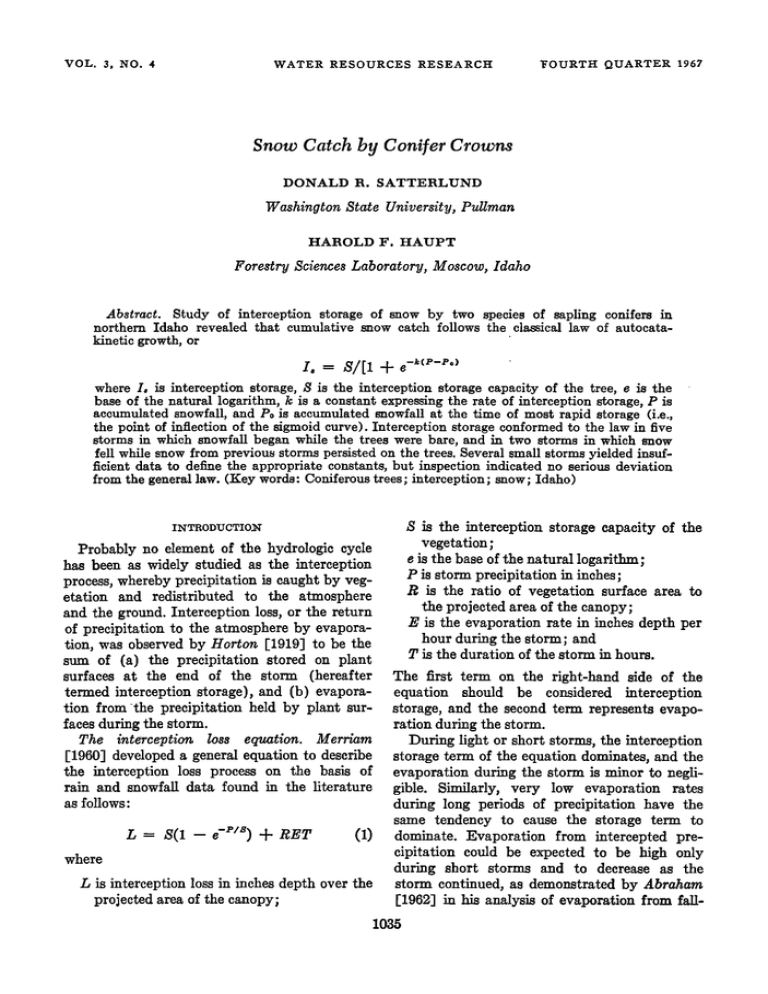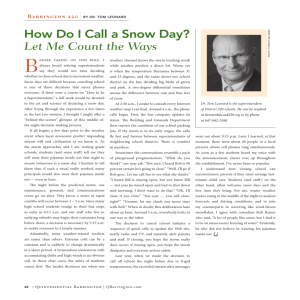Snow Catch by Contier Crowns
advertisement

VOL. $, NO. 4 WATER RESOURCES RESEARCH I•OURTH QUARTER 1967 SnowCatchby ContierCrowns DONALD R. SATTERLUND WashingtonState University, Pullmar• HAROLD F. HAUPT Forestry SciencesLaboratory, Moscow,Idaho Abstract. Study of interception storage of snow by two speciesof sapling conifers in northern Idaho revealed that cumulative snow catch follows the classical law of autocata- kinetic growth, or ' I, = 8/[1 nt- e-•½•'-•'ø) where I, is interceptionstorage,$ is the interceptionstoragecapacity of the tree, e is the base of the natural logarithm, k is a constantexpressingthe rate of interceptionstorage,P is accumulatedsnowfall,and Po is accumulatedsnowfallat the time of most rapid storage(i.e., the point of inflection of the sigmoid curve). Interception storage conformedto the law in five storms in which snowfall began while the trees were bare, and in two storms in which snow fell while snow from previousstormspersistedon the trees. Several small stormsyielded insufficient data to define the appropriate constants,but inspection indicated no serious deviation from the generallaw. (Key words: Coniferoustrees; interception; snow; Idaho) S is the interceptionstoragecapacityof the INTRODUCTIO•I vegetation; Probablyno elementof the hydrologiccycle has been as widely studiedas the interception process, wherebyprecipitationis caughtby veg- e is the baseof the naturallogarithm; P is stormprecipitationin inches; R is the ratio of vegetationsurfacearea to the projectedareaof the canopy; E is the evaporationrate in inchesdepth per hour duringthe storm; and etation and redistributed to the atmosphere and the ground.Interceptionloss,or the return of precipitationto the atmosphere by evaporation, wasobserved by Horton [1919] to be the sum of (a) the precipitation stored on plant surfaces at the end of the storm (hereafter termed interceptionstorage),and (b) evaporation from 'the precipitationheld by plant surfacesduringthe storm. The interception loss equation. Merriam [1960] developeda generalequationto describe the interceptionloss processon the basis of rain and snowfall data found in the literature as follows: L = $(1 -- e-r/s) nt- RET (1) where L is interceptionlossin inchesdepth over the projectedareaof the canopy; T is the duration of the storm in hours. The first term on the right-hand side of the equation should be consideredinterception storage,and the secondterm represents evaporation during the storm. During light or shortstorms,the interception storageterm of the equationdominates,and the evaporationduring the storm is minor to negligible. Similarly, very low evaporation rates during long periods of precipitation have the same tendency to cause the storage term to dominate.Evaporation from interceptedprecipitation could be expectedto be high only during short storms and to decreaseas the storm continued,as demonstratedby Abraham [1962] in his analysisof evaporationfrom fall- 1035 1036 SATTERLUI•D AND HAUPT ing raindrops.Miller [1966], considering the accumulatingrapidly and uniformly in a storm low vaporpressure of snowandthe lackof heat when the air temperature, initially slightly energyavailable duringthe coldand humid above freezing, fell to near 30øF [Miller, 1964]. conditionsof snowfall,suggests that evaporation The limited data suggestedthat interception of interceptedsnowmust be very slightduring storage of snow may depart from the constorms. Therefore, snow interception losses vex upward form indicatedin equation 1. Therefore, a study was set up to determine mustprimarilybe limitedto losses frominterthe factors influencingsnow catch by conifers. ceptionstoragebetweenstorms. Interceptionstorageo• snow. In moststudies This paper reports on the mechanismof interof snowfall interception, interception storage ceptionstorageduringsnowfall. has been measuredindirectly as the difference I•ETI-IOD OF STUDY between the amount of snowfall reaching the Sapling Douglas-fir (Pseudotsugamenziesii groundin the open and that reachingthe vat. glauca (Beissn.) Franco) and western groundundera forestcanopy.As a result,many of the data are of questionablevalue, because white pine (Pinus monticolaDougl.) trees were all inaccuracies and errors of measurement are suspendedin a very small openingin a sapling includedin the residualterm, and becauseof lodgepolepine stand near the headquartersof the questionable assumption that snowfallin a the Priest River Experimental Forest in northforestopeningis an accuratemeasureof snow- ern Idaho. The trees were suspendedby a light cable that passedthrough an overhead pulley fall above the forest canopy. A few studies have been made by directly and was a•tached to a spring-tensionscale. measuring the amountof snowcaughtby con- Water level recorderswere modified to provide iferoustrees.Goodell[1959] foundthat a small a continuousweight record of each suspended Engelmannspruce(Piceaengelmannii Parry) tree. A complete descriptionof the recording held about 0.2 inch, water equivalent,after a apparatus and its constructionwill be reported dry, cold snowfallof about 0.4 inch. Miller separately. [1964]weighed snowbeatenoff a younglodge- Each tree was suspendedfor a period of appolepine(PinuscontortaI)ougl.)asequivalent proximately one month, after which it was replacedby a freshlycut tree of the samespecies. tomefta (Cryptomeria japonica?) tree was A quantitative descriptionof each tree is given weighedcontinuouslythrough several snow- in Table 1. to about 0.24 inch of water. In Japan, a cryp- storms. The catch varied from storm to storm, beingleastat low temperatures near23øFbut moderateto heavyat highertemperatures(32.34øF). The snowloadsaccumulated in variable fashion,closelyfollowingthe curveof accumulated stormprecipitationin a stormwhenair temperatureremainedbetween25-27øF.,but The hourly snow catch, in pounds,was converted to the depth in water equivalent over the projected crown area of the tree to the nearest 0.001 inch in each storm. Hourly precipitation recordswere obtainedfrom the headquartersweather station,about 100 yards away. Also available were continuous records of tem- TABLE 1. Descriptionof Trees Used in Snow InterceptionStudy, 1967 Projected Tree Species Douglas-fir W. whitepine No. Dates Suspended Height to Top Whorl, Crown diam., Crown area, ft ft Needled SurfaceArea,* sqft sqft I 1/10-2/2 13.7 10.68 89.58 514.61 2 2/2-3/8 12.8 7.90 49.02 119.39 I 2 1/10-2/2 2/2-3/8 12.0 12.2 10.00 8.12 78.54 51.78 95.31 97.07 * Needled surface area is the total surfacearea of needledbranchesmeasuredas needledbranch length timesthe distancebetweenneedletips perpendicularto the branchaxis. ,Snow Catch • moist snowfallat higher temperaturesthan the previoussnowfall. Complete comparisonsof computedand ob- z .075 DOUGLAS 1037 -FIR o served snow catch were made for all storms that yielded sufficient data to define the curve. Ta- ,.. .d .050 bles2 and 3 presentthe data uponwhichfigures i and 2 are based. Most NHITE o,. PINE .025 l-- Z I I of the differences be- tween computed and observedcatch were less than 0.01 inch. The largest difference,0.036 inches,arosewhen snow slipping from a small, I overloaded branch fell and the force of its fall dislodgedlarger massesof snow from lower SNOWFALL, INCHES, branches.However, accumulationresumedand WATER EQUIVALENT (P) was approachingthe computed storage capacity when snowfallended. Several small storms yielded insufficientsnow (circles and crosses). to definea relationshipbetweencatch and snowfall, but inspectionof the data gave no indication that the general form of the curve was perature,relative humidity, and solarradiation. differentin smallthan in largerstorms. z _ 0 Accumulated .10 wind .20 movement .30 .40 was measured daily. Wind was not an important factor in this study, as all snowfall occurred under calm or nearly calm conditions. RESULTS DISCUSSIOlq' Growth of any kind in which the substance or structure itself acts as the base for the further accumulation of the same substance or When accumulatedinterceptionstoragewas plotted against accumulatedsnowfall for each storm and tree, a surprisingsimilarity of form appeared.Each plot, though differing in slope .150 DOUGLAS-FIR and varying in height, seemedto definethe well known sigmoid growth function. Consequently, the formula for each curve was derived from the data accordingto methodsoutlined in Lotka [1956], and a computedcurve wasfitted to the data. Figuresi and 2 illustrate typical results. The generalequationfor snowcatchis I, = S/J1-[- e-•(P -- Po)] .125 ,,• .•. z •, --' .1 O0 • "' .075 WHITE PINE z • (2) where S, e, and P are as previouslydefined; I, is interceptionstorage; k is the constant expressingrate of interceptionstorage; '• • 050 I-. z z .. .025 Po is the amount of snowfall accumulated at the time of most rapid storage (i.e., the point of inflectionof the sigmoidcurve). 0 .10 WATER Equation 2 held when the trees were bare of snow at the start of the storm and when trees loadedwith dry snowwere subjectedto a more .20 SNOWFALL, .30 .40 INCHES, EQUIVALENT (P) Figure 2. Snow catch during storm of January 12, 1967. Computed curve fitted to field observations (circles and crosses). 1038 SATTERLUND TABLE 2. AND HAUPT Snow Catch by Douglas-firand WesternWhite Pine. TreesBare at Start of Storm. Priest River Experimental Forest, Idaho. Storm of January 10, 1967 Interception Storage,Inches Water Equivalent Cumulative Hourly Snowfall, inches,w.e. Douglas-fir Observed Computed* Difference 0.005 0.008 0.025 0.060 0.071 0.074 0.02 0.04 0.15 0.22 0.30 0.037 0.002 0.003 0.027 0.055 0.071 0.074 WesternWhite Pine Observed Computed$ Difference 0.003 0.005 0.002 0.005 0 0 0.004 0.005 0.013 0.038 0.043 0.046 0.001 0.002 0.015 0.034 0.044 0.046 0.003 0.003 0.002 0.004 0.001 0 Temp., øF 32 32 32 32 32 33 * I, = 0.075/1 -+-½-2a.o7(P-o.175) i I, = 0.047/1 + ½-2a.66(P-o.15o) structure may be termed 'autocatakinetic' growth [Lotka, 1956]. Accordingto this concept, growth would continue. at an ever accelerating rate in the absenceof external constraints. In any complexsystem,however,constraints exist that limit growth at some point. There are two points of equilibrium: a lower, in which growth is absent for want of the growth substance,and an upper, at which growth is limited by the constraintsof the system. Starting at the point where the substance is first present,growth beginsto accelerateand continuesuntil the limits of the systemare approached,then deceleratesuntil a new equilibrium is establishedat the limits of the system. For example, a bacteria population in a petri dish containingagar definesthe locus of the well knownequationof populationgrowth. TABLE 3. An analogoussituation existsin the development of interceptionstorageof snowby coniferous trees. The first snowflakesstriking the canopy often bounce off the needlesand fall through all but the smallest spacesbetween them, bridging acrossthe smallest.With continued snowfall, more and more bridges are formed acrosslarger and larger gaps,providing a continuouslyincreasingplatform upon which more flakes can come to rest. As the snow builds up, however, most of the bridgeable gaps are bridged, and the platform area increases at a slower rate. Heavier snow loads on flexible branchesbend them downward,and at some point the tree can hold no more snow. Thereafter, the excessslides or falls from the canopy, as rapidly as it falls from the sky. During calm periodsthe size, form, and wet- Snow Catch by Douglas-fir and Western White Pine. Trees Bare at Start of Storm. Priest River Experimental Forest, Idaho. Storm of January 12, 1967 ,, Interception Storage, Inches Water Equivalent Cumulative Hourly Snowfall, inches, w.e. 0.02 0.05 0.13 0.17 0.23 0.27 0.29 0.37 Douglas-fir Observed Computed* Difference 0 0.004 0.012 0.047 0.090 0.114 0.137 0.146 0.001 0.001 0.012 0.034 0.094 0.125 0.134 0.145 * I, : 0.146/1 -t- ,-29.75(r-0.210) $ Io : 0.098/1 + 0.001 0.003 0 0.013 0.004 0.011 0.003 0.001 WesternWhite Pine Observed Computedt Difference 0.001 0.012 0.023 0.053 0.075 0.097 0.097 0.094 0 0 0 0 0 0 0 OO2 005 026 049 080 091 093 0.097 0.001 Temp., øF 33 0.007 32 0.003 0.004 0.005 0.006 0.004 0.003 32 31 31 32 32 33 Snow Catch ness of the snowflakes determine the rate and degree of bridging during any given storm, whereasthe form, surfacearea, and strengthof the branches determine the ultimate snow load that can be borne. There is an interaction be- tween snow cohesionand branch strength, for 1039 Center, Pullman, project 1849. This investigation was supported in part by Cooperative State Research Service Funds from the McIntire-Sten- nis forestry research program and was conducted in cooperationwith the U.S. Forest Service, Intermountain Forest and Range Experiment Station, Moscow, Idaho. snow bridges distribute the load so that REFEREI•CES branchesgive each other mutual support, inAbraham, F. F., Evaporation of raindrops,J. Geocreasingthe load capacity of the tree. phys. Res., 67, 4673-4682,1962. Interceptionstorageof snowthereforediffers Goodell, B.C., Management of forest stands in from interceptionstorageof rain. Liquid water western United States to influence the flow of forms a thin film surroundingthe existing surfacesof the tree, whereassnow bridgesacross gapsand thereby createsits own surfaceupon which further snowfall can be retained. In short, there is no universal interception storage equa- tion, and since interceptionstorageis the snow-fed streams, Intern. Assoc. Sci. Hydrol. Publ., 48, 49-58, 1959. Horton, R. E., Rainfall interception, Monthly Weather Rev., 47, 603-623, 1919. Lotka, A. J., Elements of Mathematical Biology, Dover Publications,Inc., New York, 465 pp., 1956. Merriam, R. A., A note on the interception loss interceptionloss, there can be no universal equation, J. Geophys. Res., 65, 3850-3851, 1960. Miller, D. I-I., Interception processesduring snowinterceptionloss equation. storms, Pacific S.W. Forest and Range Expt. Further consideration of the redistribution of Sta. Res. Paper PSW-18, 24 pp., 1964. interceptionstorageto the atmosphereand the Miller, D. I-I., Transport of interceptedsnowfrom trees during snow storms, Pacific $.W. Forest groundalsosuggests differences of greatmagniand Range Expt. $ta. Res. Paper PSW-33, 30 tude betweensnow and rain. But that is a sepdominant element in either snow or rainfall arate questionand is alsounderinvestigation. Acknowledgments.Scientific Paper No. 2977. WashingtonState University AgricultureResearch pp., 1966. (Manuscript received June 1, 1967; revised August 1, 1967.)







